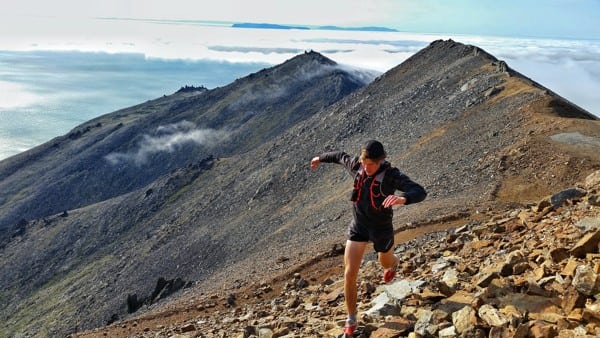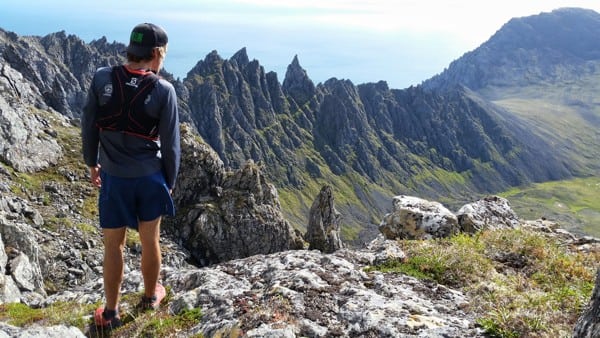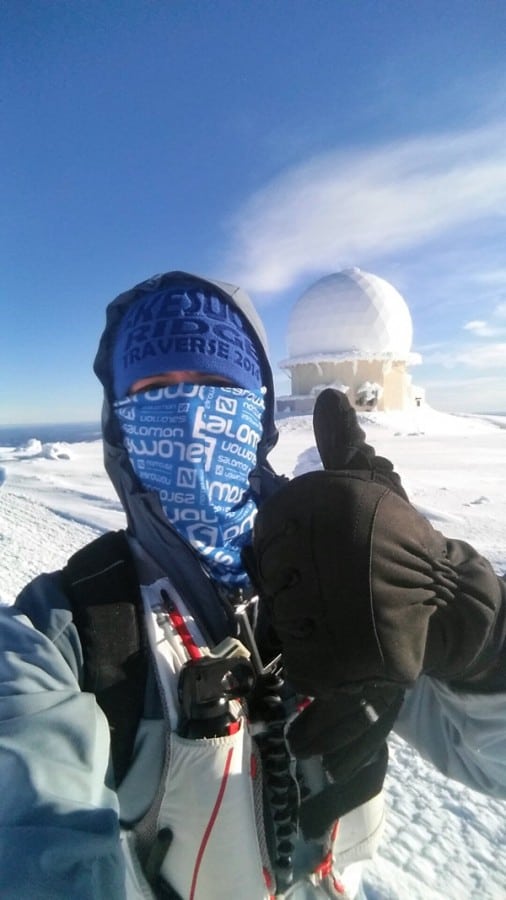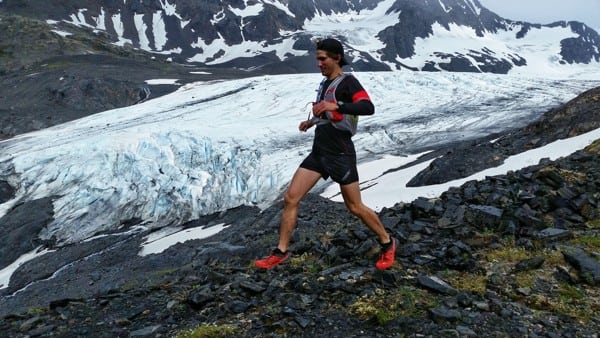[Editor’s Note: This interview was conducted by guest contributor Evan Hone.]
I have wanted to interview Allan Spangler for a while now. He is a super cool trail and mountain runner from Alaska who has created quite a name for himself within the state in both short and longer distances. Recently he has received outside-of-the-state attention with his eighth place at the 2015 The Rut 50k and ninth place at 2015 The North Face Endurance Challenge 50 Mile Championships. In the following interview, I dig into his past, learn about his present, and find out what his future holds in trail running, which includes a summer of racing trails internationally.

Allan Spangler. All photos courtesy of Allan Spangler unless otherwise noted.
iRunFar: Tell me about your childhood and what got you into running?
Allan Spangler: My childhood was very idyllic. Just watch The Sandlot and you will have a better idea than if I tried to describe it to you. I grew up in what were then the outskirts of Wasilla, Alaska. There were plenty of woods and adventure to be had. I didn’t actually hike much. Most of my time in the mountains was spent snowboarding. Secretly, I still prefer running in the forest versus running in the mountains. I’ve really always enjoyed running. Starting in first grade, I remember spending a concerning amount of time running laps on the gravel track during recess. I would try and see how many laps I could run in one recess on occasion. I ran on the cross-country team in fourth grade, which was when you could first join the team. I remained on the school team through high school and even ran my sophomore year in college.
iRunFar: How did you get into trail running?
Spangler: I have always preferred trails. Among many other things I enjoy the solitude they provide. Trail running of the organized ultra-racing type started for me back in 2007 when I first ran the Crow Pass Crossing. That race always captivated me in high school. Every year you would see photos in the Sunday newspaper after the race of people crossing the mountain pass with Raven Glacier in the background and I knew I had to do it. [Author’s Note: Allan has the fourth-fastest time ever and is only one of four people to break the legendary three-hour mark on the 22.5-mile mountain course.]

Allan and Raven Glacier in Girdwood, Alaska. Photo: Nina Schwinghammer
iRunFar: What is your favorite race and what distance do you prefer?
Spangler: Kesugi Ridge Traverse is thus far my favorite race. I shouldn’t have said that, though, as it fills quickly and has an 80-person cap. It is a wild unsupported, uncontrived, point-to-point race. You run along, filling water from creeks and dodging brown bears for 28 miles along an alpine ridge with an awesome view of Denali to your right the entire time–or so I’m told. Every time I’ve raced, hiked, or run the trail, it has been during a horrendous storm. I like any race that feels like an adventure. Consequently I keep getting drawn into longer and longer races. I also tend to do a lot better in longer races. Currently I would have to say that I prefer races that are three hours or longer, but I have never raced much longer than seven hours.
iRunFar: With all the great races in state, what’s made you want to start racing outside?
Spangler: While the races and the competition in Alaska are both top notch, Alaskans all typically wonder how they stack up in the real world outside of Alaska. So I would say it’s partly the competitive aspect of racing against people you’ve only heard about, in races you’ve only read about. The other aspect is simply the adventure of racing somewhere new. Obviously Alaska provides ample surprises and adventure, but something as simple as running on a different type of soil or running into the wrong kind of foliage can turn a normal race into a major struggle for the newcomer.

Running near a work location at the Tin City radar site in western Alaska. Russia can be seen in the background.
iRunFar: What are your thoughts on living and training in Alaska as it applies to flying down to race in the continental U.S.?
Spangler: A major advantage to training in much of Alaska is the quick access to a number of trailheads and mountains. Having traveled to every corner of the state for work has also provided me with some unforgettable scenery and some challenges. The challenges are mostly of the furry four-legged kind. I have literally been stuck inside for over a week at one of our work sites because at any given moment you could look out the window and see over a dozen polar bears lounging on the tundra nearby. The two hardest things to deal with when racing outside of Alaska are elevation and the heat. Also training for nearly six full months on ice and snow presents a lot of difficulties if you can’t handle running on a dreadmill. In leading up to a race, I start two months out doing progression workouts. I usually follow a very detailed Steve Magness marathon-training plan and try to average between 90 and 120-mile weeks. The training plan helps me with accountability and keeps me on track. Because of work commitments I tend to do my training alone (during lunch and after work) but I do like to get out of hikes with my fiancée Nina.
iRunFar: Tell me about your training and preparing for The Rut and TNF EC 50 Mile. Was altitude a big factor for The Rut?
Spangler: Despite having a lot of mountains everyone basically lives at sea level in Alaska. Prior to The Rut this year, I believe the total number of days in my life I have spent above 5,000 feet was three. That race destroyed me when we were over 9,000 feet. I showed up two days beforehand, which I believe was the perfect amount of time for my blood to reach peak viscosity. My head felt like crude oil was pumping through it. Leading up to The Rut my training was very spotty. My job is primarily a construction-management position and the peak season is June through September. I was out of town at our remote sites for three out of four weeks leading up to The Rut so my training primarily consisted of tromping through the tundra at about 11-minute pace. While this was very scenic, 11-minute pace on flat, spongy ground isn’t exactly great specific training. Somehow The Rut ended pretty well, with a pretty good comeback during the last seven miles after a scenic out-and-back detour.
Training leading up to TNF EC 50 Mile was much more ideal despite running almost entirely on ice and snow. I had more time and was able to stick to a fairly standard marathon-training plan. I don’t focus on climbing–I’ve always figured that climbing is really more of a general fitness test and you will be able to climb well as long as you are in good shape. I actually added in a lot of downhill training for TNF EC 50 Mile. More so than climbing, the continuous eccentric loading of a long downhill is what will seize up your legs. I believe this downhill-training strategy worked very well as my pace on the flats and on the downhills did not deteriorate too much throughout the race. Although, my climbing really suffered late in the race… so you win some you lose some.

Allan Spangler at Cape Newenham, just north of Bristol Bay, at a radar site. Photo: Nina Schwinghammer
iRunFar: You obviously converted your mountain strength to the faster leg-turnover stuff needed to run well at TNF EC 50 Mile but what about the competition aspect? How’d you deal with the mental part of going into a big race?
Spangler: Not well. TNF EC 50 Mile was the biggest and most competitive race I have ever done. I hadn’t felt great about any of my race results since running Capitol Peak in April and was feeling desperate for a solid result. My life for the two months leading up to the race reflected this desperation, which then manifested as hysteria during the race. I attacked the first climb up to Cardiac with a bit too much optimism. What followed were 30 unsympathetic miles, where I ignored the suffering of my legs. I was pretty sure I was going to crater by mile 40. However, I was desperate, so I apologized to my legs and decided I was going to maintain pace for as long as possible even if that meant blowing up at mile 40 and walking it in for 10 miles. I just kept telling myself to hold this pace until mile 40 and worry about the rest later. Somehow I maintained some respectable paces on the flats and descents, but every climb after passing through Muir Beach for the second time was becoming more of a shuffle. Next year I hope to maintain my head better and have a smoother race.
iRunFar: Can you explain a little more about what you have been doing for work and the animal challenges you encounter at your job sites?
Spangler: I am a facility engineer for ARCTEC Alaska, a contractor that operates and maintains the Alaska Radar System. The radar sites were built in the 1950s to detect Russian aircraft and missiles. While that remains a capacity of the radar system it is primarily used for air-traffic control and navigation these days. The radar sites are permanently manned with a skeleton crew of two to four people. Due to the extremely remote locations of these sites, many of the sites are required to generate their own electricity. So between the onsite power plants and the systems required for people to live comfortably on the arctic coast of Alaska, there is plenty of work to be done.
Since these sites are located on the coast and if available on top of mountains my job has allowed me to travel to some amazing corners of Alaska. I spend about four out of five weeks on average in the office, which is located in Anchorage, Alaska. When I do travel to the radar sites I am typically there for one to two weeks. Most of these trips occur during the summertime. While this allows for some amazing and wild runs, the schedule, weather, and wildlife often interfere.
My two biggest concerns while running in the barren grounds of western Alaska are bears and fog. There are a lot of bears in some of these locations. It’s a bit hard to enjoy a run when there is a bear that may potentially get between you and the main camp. I’ve never had an issue with a curious or aggressive bear but it’s still unsettling knowing that the situation is entirely in the bear’s control.
However, thus far my most memorable wildlife encounter was in August and involved a wolverine. I was just outside of a main camp and was about to head out for a run when I saw what looked like, and actually was, a giant weasel. It was galloping aimlessly into the tundra. I whipped out my phone and started recording. Then to my surprise it turned and headed straight toward me. I figured it was just a coincidence and there was no way it knew I was there. But it just kept coming. The fight or flight response in my head was triggered. To run or not to run. While wolverines are typically only about 40 pounds, they are 40 pounds of teeth, claws, and uncompromising hatred. I ran.

Allan on the summit of Indian Mountain, at a radar site in the Alaska interior.
iRunFar: What are your racing plans for 2016?
Spangler: Europe! Nina and I have purchased one-way tickets for mid-March to Europe. So this season I’ll be missing out on all that Alaska has to offer. This is perhaps squandering my last year in the 20-29 age group. My race schedule while being planned is still very rough but I am planning on doing the Tromsø Skyrace and Glencoe Skyline, which are now part of the new Extreme classification of Skyrunning. I would also like to work on qualifying for the 2017 UTMB. I am currently planning on returning for TNF EC 50 Mile in 2016, though.
iRunFar: What is on your bucket list?
Spangler: The trip this summer is checking off a big item from my bucket list. I’ve always wanted to bail out on my job and start an indefinite trip. I also plan on finding out just how far I can pursue running and either concurrently or afterwards start a small construction company, small farm, or a business which helps small farms sell their produce. As far as running goes I would like to race UTMB, The Alaska Wilderness Classic, attempt an FKT on the Anchorage Front Range linkup, and start a mountain and trail stage race based in the Anchorage area.
iRunFar: Is there anything else you would like to add?
Spangler: I was thinking a bit more about what you asked me, something along the lines of, “How much of a priority is running for you or how obsessed are you?” I don’t want to downplay that I am seriously trying to improve and have some lofty although vague goals in mind. It’s just that I am really trying to focus on longevity versus having one amazing season. Building slowly on one’s fitness over a span of years is something that is often forgotten when a runner initially finds success. However, if you look to professional athletes such as Kikkan Randall (Alaskan Olympic cross-country skier and mountain runner) you often see that to reach that absolute top tier of elite performance you need to train and recover in a way that allows consistent progress year after year. Progress which is typically blocked by either an injury or mental burnout. I am perhaps a bit obsessed about running and would like to be able to focus on it more, but I want to do so in a way that fosters enjoyment of the process and allows for years of great results.
iRunFar: Thanks, Allan, and we wish you nothing but the best in 2016 and beyond!

Allan and Raven Glacier. Photo: Nina Schwinghammer
